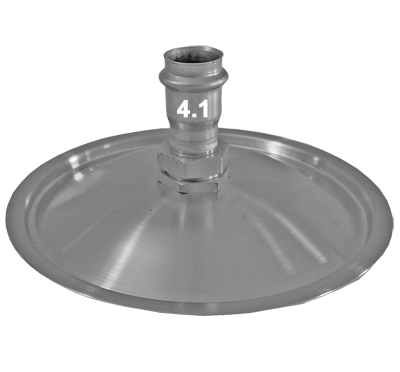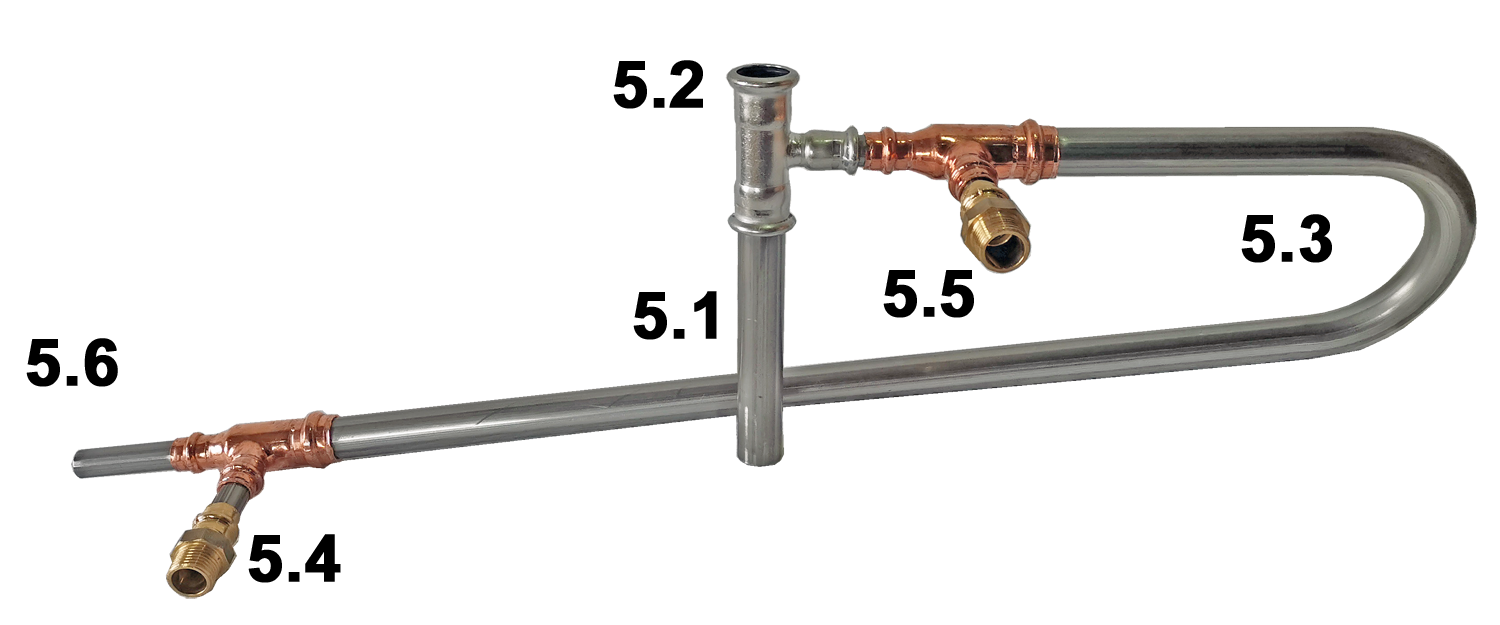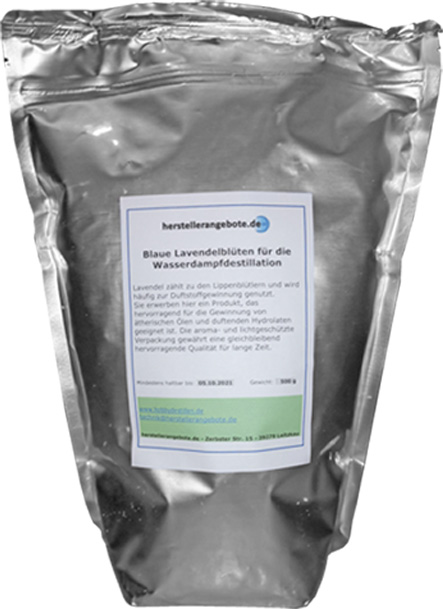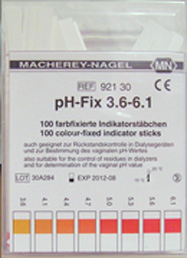Construction of optimised stills since 2006
DESTILLIERMEISTER E10-4 Supreme-Plus - with all the accessories you need for professional work
NEW! No more silicone seals required
You save €50 compared to buying separately
Legal, registration-free still made of stainless steel for essential oils and with a full 4 litres of plant space.
This unit itself differs from the previous version in the following improvements:
- The boiler and the plant tube are not rigidly connected but can be separated by means of a 3/4 ‘-V4A screw connection.
- The plug-in socket for the distilling bridge, plugged tightly, is made of high-quality V4A stainless steel (instead of red brass in the standard version).
- The plant basket is height-adjustable, so that smaller quantities can also be distilled.
25 ml of essential oil in 8 minutes – that's what we achieved with 400 g of lavender flowers.
With 4 litres of plant space, you have plenty of volume to process larger quantities of plants or drugs. The steam is generated in a separate boiler under the plant container, so that contact with boiling water can be ruled out.
Easy to use:
- In the new model, no seals are required between 1 and 2 or 3 and 4 due to optimised clamping locks. Sealing works metallically. Therefore, there are no follow-up costs for this model.
- Fill the water/steam boiler with at least 2 litres and no more than 8.5 litres of ideally demineralised or distilled water.
- Insert the 4-litre plant tube and close the boiler with the clamping locks 1.1.
- Insert the aroma basket into the plant tube and open it.
- Fill to the brim with herbs or drugs - do not compress. There are about 4.2 litres.
- Put on the lid 3. and tighten the fasteners 2.4,
- insert the distillation bridge 5 into the socket 4.1,
- screw the cooling water hoses to the cooler.
- Switch on the heat source and collect the hydrosol with oil at 5.6.
- Distil for about 8 minutes at higher power (induction plate 3000 watts). There should be 500 ml of distillate.
The water/vapour vessel and the plant/drug tube, as well as all distillate-carrying pipes and connections, are made of stainless steel.


Aufbau

Details
- Water/steam boiler with lid, 10.5 litres. Approx. 8.5 litres of water are filled in.
- 4 quick-release fasteners for securely closing the water/steam boiler.
-
- Lid
- 3/4’ screw connection for connection to the plant tube

- Plant/drug tube, approx. 4.2 litres capacity.
- Screw nipple for connection to the water boiler,
- 4 clamp fasteners for closing the plant tube using the lid 3.

- Lid with socket for the distillation bridge 4.
- Socket made of V4A stainless steel.


- Distillation bridge with curved counterflow condenser with a generous 90 cm cooling length. This is practically impossible with the classic Liebig condenser.
- Riser tube
- Thermometer socket
- Double-tube condenser in counterflow (outer jacket, inner core. The cooling water flows between the core and the jacket, and the vapour or liquefied distillate flows in the core. The cooling water and distillate flow in opposite directions.)
- cooling water inlet
- hot water outlet
- hydrosol outlet
-

- digital thermometer with silicone stopper, insert in 5.2.
- aroma basket with adjustable legs. When the tube is completely full, insert the aroma basket into the steam tube without screwing in the adjustable legs. The aroma basket should then be about 3 cm from the floor and have a closed storage area in the middle, so that the rising steam jet does not flow directly through the plants and create a tunnel due to the jet effect, which would lead to significant losses. Because of the storage area, the steam first flows radially and then rises due to its own thermal properties. The plant tube has a height/diameter ratio greater than 1, so that an effective chimney effect promotes the drag effect. If you also want to work with smaller quantities of plants, you can screw in the legs and adjust the height of the basket. Caution: when only half full, do not heat with more than 1500 watts.


Collecting, separating and analysing

- 500 g of blue lavender flowers in distillation quality in an aroma and light protection bag.

- Aid to direct the hydrolate into the separating funnel.
- Bow to put on the distillate outlet 4.6. This is used when everything is on one level, e.g. when using an electric stove.
- Slip-on sleeve with hose. The sleeve can be pushed either directly onto the distillate outlet 4.6 or onto the elbow 8.1 if the distillation apparatus is placed on a raised hotplate (example in the picture below). You may have to shorten the hose, depending on the hotplate. Under no circumstances should the hose be immersed in the hydrolate.

- Set for cooling water supply with the following accessories
- 20 litre plastic bucket as cooling water reservoir.
- Powerful 230V cooling water pump with accessories for different hose diameters, sufficient for all our stainless steel stills up to about 20 litres.
- Various 2-metre PVC hoses, including two hoses with screw connections for the distillation condenser, one of which is prepared for connection to the pump. In addition, three hoses of different thicknesses for various applications, e.g. hose extensions or decanting hydrosols, etc.
- Plastic tap for cooling water control, suitable for the counterflow condenser.
- Scaled 100 ml measuring cylinder with foot to take distillate samples, e.g. to measure the pH value.
- Cleaning brush.
- Floating thermometer to check the cooling water if you let the hot waste water run back into the bucket. From 40° C the water should either be cooled with ice or replaced.
- A roll of Teflon tape for sealing, e.g. if something drips during distillation.

- Oil separation device, consisting of the following components
- The separating funnel. This is where the hydrolate is collected first.
- PTFE plug. In the picture, this is set to maximum flow. Turned 90° it closes completely. At the beginning of the distillation it is closed. When about 60 to 70 ml have been collected, it is opened slowly and the hydrolate is allowed to flow out. It is best if the hydrolate flows out into the receiving flask as quickly as it flows into the separating funnel. The oil collects on the surface of the hydrolate in the separating funnel.
- Stopper for the receiving flask with a feedthrough. This stopper is replaced by a rubber stopper in the newly delivered devices, as this is more stable. Here, a pressure equalisation must be created so that the hydrosol can drain without bubbles. To do this, a notch is carved from top to bottom into the edge of the stopper. This is sufficient for pressure equalisation.
- Receiving flask (Erlenmeyer flask – may vary in appearance depending on the supplier). You should definitely distil 500 ml; the non-water-soluble essential oil has now almost completely been distilled off. If you want to collect more hydrosol, you should briefly switch off the heat source, decant the hydrosol or place a new flask underneath. Don't forget to close the 9.2 plug during this operation.
- Closure stopper, fits on the separating funnel. This is not needed for distillation.


- pH test strips, pH between 3.6 and 6.1, 100 pieces. A hydrosol with a pH below 4 is of very high quality. From pH 6 or above, you should decide whether you want to stop the distillation. The hydrosol will still smell good, but will not keep as well.

Test run with an identical system
Heating source: Induction, power after heating time (approx. 3 min) 3000 watts. This power should be lower if the system is not completely full.
Drug: Dried lavender flowers
Quantity: 400 g
Total distillation time: approx. 16 min
Hydrosol extraction: 2 batches, one every 8 minutes.
- Batch: 500 ml after 8 minutes, oil yield 25 ml, hydrosol pH value: 3.2.
- Batch: 500 ml after a further 8 minutes, no oil, hydrosol pH value: 3.6.
The moisture content may vary depending on the harvest or harvest time. Rain shortly before harvest can significantly reduce the yield. Harvesting should take place after at least 2 days of sunshine.
Important notice:
This still can be sold legally in Germany without registration with the authorities under the new German alcohol tax law since 1 January 2018. Please note that, as a dealer, we must point out that this still may only be used for the distillation of distilled water, hydrolates, essential oils, aromas, fragrances, perfumes, food, for alchemical experiments, etc. or as a collector's item. If you distil alcohol and get caught, you will have to expect a fine and the confiscation of the distillation equipment. However, I can give you a legal tip. You can make delicious spirits from hydrosols by mixing them with taxed alcohol and water to drinking strength. Try a spirit made from fennel seed hydrosol.


















